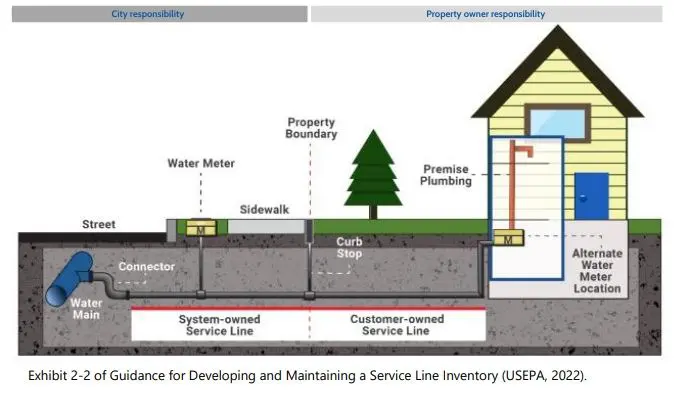While the City of Bellingham has proactively removed lead pipes from our service lines that connect our water mains to private property, there may still be lead pipes present in some homes, particularly those built prior to 1986 when lead pipes were banned in construction.
Lead in drinking water is a serious health concern that can have adverse effects on human health, especially in children. It’s important to understand how to address lead if found in drinking water. When lead is found in drinking water, it typically comes from water distribution lines or household plumbing, rather than lakes, wells or streams. Over time, lead can leach into the water, especially if the water is acidic or corrosive.
Addressing Lead in our Water System
We have taken proactive steps to address potential sources of lead in our water system:
- Water treatment: While we are fortunate that lead is not found in Lake Whatcom, our drinking water source, our Water Treatment Plant uses advanced filtration and disinfection to remove contaminants. Water quality testing is performed throughout the day at various locations in the water treatment plant with online monitors, verifying its safety 24 hours a day. More information about treatment can be found on our Water Treatment webpage.
- Corrosion control: We monitor and adjust treatment to minimize risk of lead leaching from pipes and fittings. pH levels are continuously monitored to inhibit corrosion in the system.
- Water quality monitoring: Extensive water quality monitoring is done throughout the distribution system each day. Treated water quality is monitored to meet the requirements of the Safe Drinking Water Act and the requirements of the Washington State Department of Health.
- Service line replacement: As of March 2018, we have removed all lead service lines and galvanized service lines from our water mains to private property.
What is a Service Line?
A water service line refers to the lateral connection to the City’s water main. It includes the public water service and water meter, both of which are maintained by the City. We utilize only copper, brass, and ductile iron for these connections. A private water service is defined as the connection between the public water meter and your home. This pipe is considered private property and is maintained by the property owner. If your home was constructed before 1986, the year lead pipes were prohibited for use in construction, there is a possibility that your private service may contain lead.
Service Line Inventory
The U.S. Environmental Protection Agency’s (EPA) Lead and Copper Rule Long-Term Revisions were published on January 15, 2021. One of the key provisions in this rule is a requirement for all community water systems to develop and maintain a publicly accessible lead service line inventory. The predominant driver for the inventory is to identify and ultimately remove these significant sources of lead and provide information to customers of the presence of lead service lines in their communities. These requirements are aimed at providing better transparency and improving protections for communities from the risks of lead exposure.
In compliance with federal requirements, we completed a comprehensive service line inventory in October 2024. This inventory includes the following components for each service address:
- City-owned portion: The material used in the service line from the water main to the water meter.
- Customer-owned portion: The material used in the service line from the water meter to the house.
- Total service line material: The combined material of both the City-owned and privately owned portions.
The image below is an example depicting the City’s responsibility to maintain from the water main to the meter box. The customer is responsible for the line from their property line to inside the home. Exact configuration varies from home to home.

Inventory Search Tool
City service lines do not contain lead pipes. Use our search tool to determine what our analysis found for the kind of material used on your service line.
Determining the Privately Owned Portion
Due to the limitations of accessing private property, we determined the material of the privately owned portion based on a statistically significant sample of service lines leaving the City-owned meters. This analysis revealed that none of the sampled lines were made of lead.
Important Note: While our statistical analysis indicates a low likelihood of lead pipes in the privately owned portion, it’s possible that individual homes may still have lead service lines.
Additional Resources
If a resident suspects lead pipes within their home, they can conduct testing. The only way to know the amount of lead in your water is to have it tested by contacting an accredited water testing lab. You can search for a lab at https://apps.ecology.wa.gov/laboratorysearch
If you have questions about the health impacts of lead, please visit the Washington State Department of Health contaminants website.
Questions?
Contact Public Works at (360) 778-7700 or askpw@cob.org
